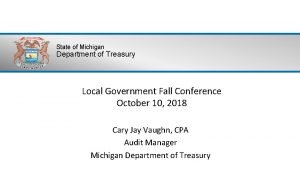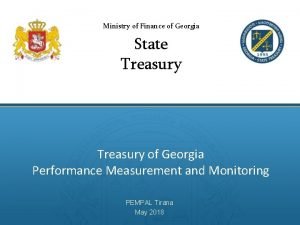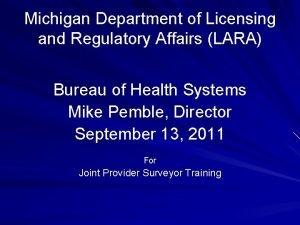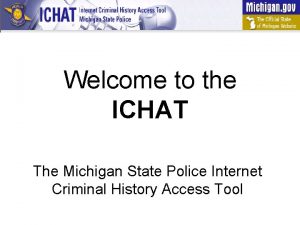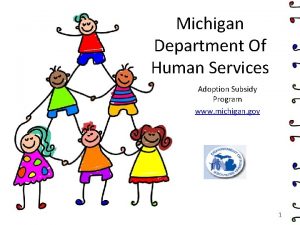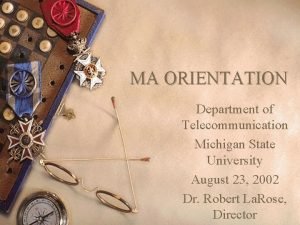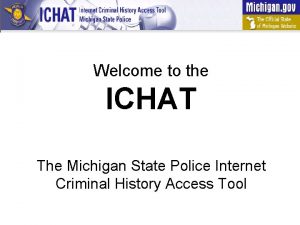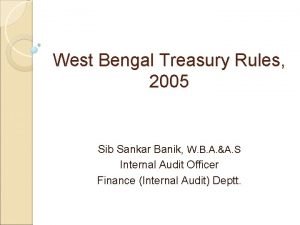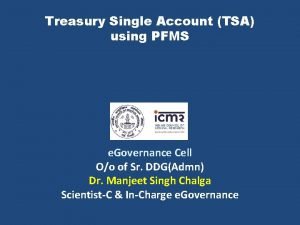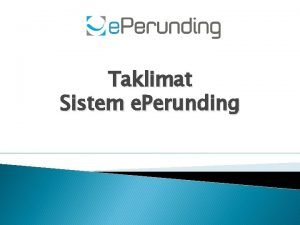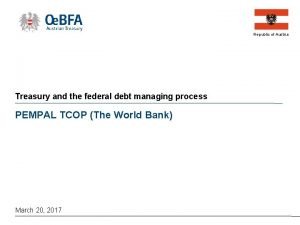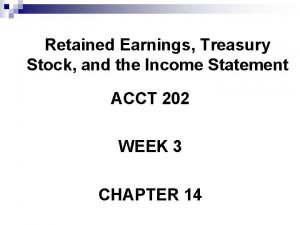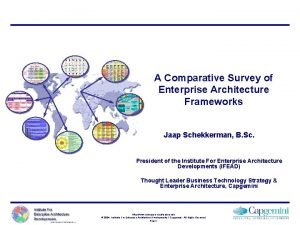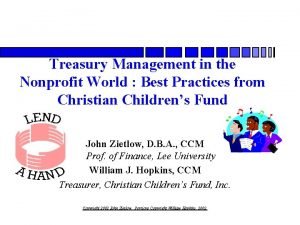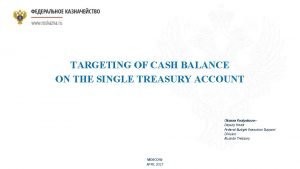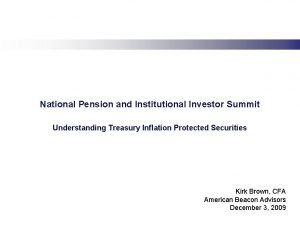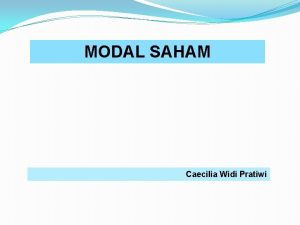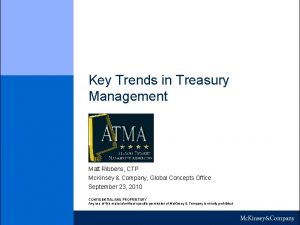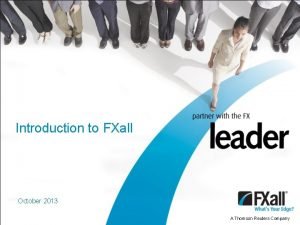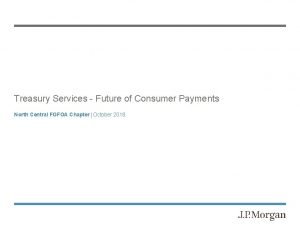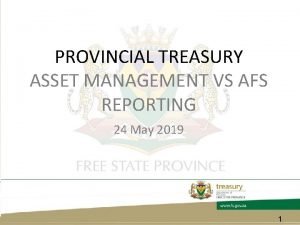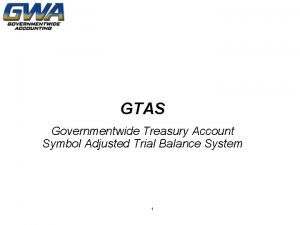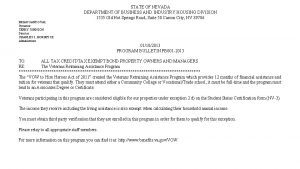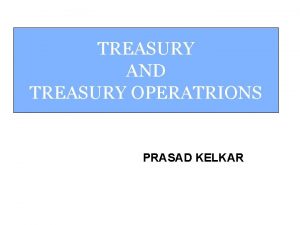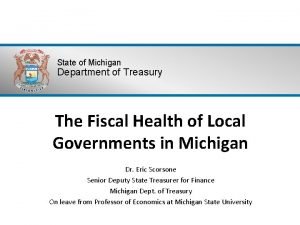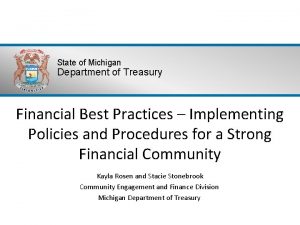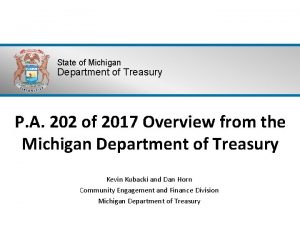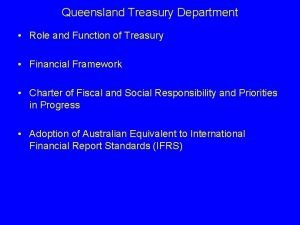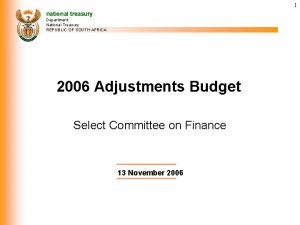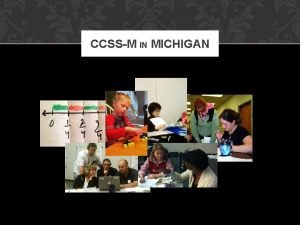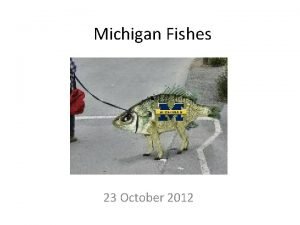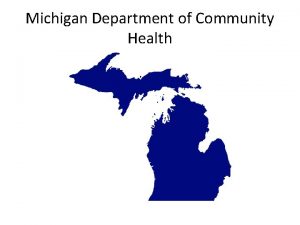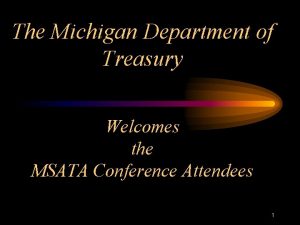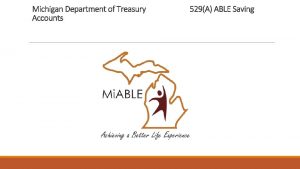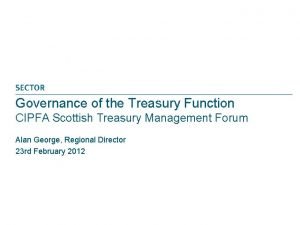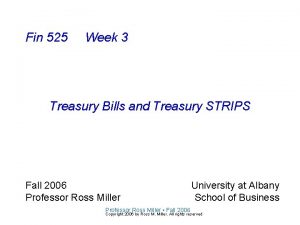State of Michigan Department of Treasury P A


















































- Slides: 50

State of Michigan Department of Treasury P. A. 202 of 2017 Overview from the Michigan Department of Treasury Kevin Kubacki and Dan Horn Community Engagement and Finance Division Michigan Department of Treasury

Today’s Discussion Topics • Understand the intent and methodology of the new law • Guide you through implementation and best practices to assist you in complying with the act • Overview of the Municipal Stability Board and criteria they are using to evaluate plan solvency • A look at what’s ahead State of Michigan Department of Treasury 2

PA 202 of 2017 Background • Protecting Local Government Retirement and Benefits Act (PA 202) implements the recommendations from the Responsible Retirement Reform Task Force • The act incorporates four stages: • The act is not perfect – implementation challenges! State of Michigan Department of Treasury 3

Reporting Requirements and Timeline Report Due Date Retirement System Annual Report (Form 5572) No later than 6 months after the end of fiscal year Waiver (Forms 5582 and 5583) 45 days from preliminary underfunded status determination Corrective Action Plans (Form 5597 and 5598) A local unit shall submit a Corrective Action Plan to the board within 180 days after determination of underfunded status Summary Health Care Report TBD Uniform Actuarial Assumptions Implementation beginning in 2019 Summary Pension Report (Public Act 530) 30 days after the annual valuation State of Michigan Department of Treasury 4

FORM 5572 SUBMISSION AND EVALUATION State of Michigan Department of Treasury 5

Evaluation Process Form 5572 Preliminary Underfunded Not Preliminary Underfunded Waiver Corrective Status Process Action Plan (Optional) Form 5597 Form 5582 Form 5598 Form 5583 Corrective Action Plan Monitoring (TBD) Waiver Granted End State of Michigan Department of Treasury 6

Underfunded Status Triggers • Public Act 202 provides criteria for underfunded status (Triggers) Funded Ratio Health system <40% Pension <60% ARC/Governmental activity fund operating revenue for primary units* >12% and >10% • Another trigger: Failure to submit the report *Only applies to primary units (cities, villages, townships, and counties), non-primary units are only based on the funded ratio trigger State of Michigan Department of Treasury 7

Updated Retirement System Annual Report • Healthcare Tab updated September 28 th. State of Michigan Department of Treasury 8

Data Sources: Audited Financial Statements Item Statement From Financial Statement Total governmental fund revenue Statement of Revenues, Expenditures and Changes in Fund Balances – Governmental Funds From Notes; or Required supplementary information System Assets and Liabilities For pension: Schedule of Changes in the Net Pension Liability and Related Ratios For OPEB: Schedule of OPEB Funding Progress and Employer Contributions ADC (Pension) Schedule of Contributions ARC (Retiree Healthcare) Other Postemployment Benefits From Retirement System or Local Unit Accounting Records Payment of retiree insurance payments State of Michigan Department of Treasury Payment of Normal Cost for employees Speak to your actuary about the calculation and 9

PA 202 Total Reporting Data Retirement Review Analysis (Form 5572) FY 20171 Status Option Primary Units Non-Primary Units Total Preliminary Underfunded 111 (20%) 136 (40%) 247 (28%) Approve 427 (79%) 199 (58%) 626(71%) Deny 3 (1%) 6 (2%) 9 (1%) 541 (61%) 342 (39%) 883 0 2 2 541 (61%) 344(39%) 885 Total-Reviewed Pending Treasury Review Total-Submission 1 As of 10/2018 State of Michigan Department of Treasury 10

PA 202 Reporting Data 2017 Retirement Data Pension Funded Ratio Primary Units 74. 9% 32. 0% 5. 8% Non-Primary Units 75. 8% 2. 4% 33. 5% 2. 7% Total 75. 0% 3. 6% 32. 2% 5. 1% State of Michigan Department of Treasury Pension ADC/Revenue OPEB Funded OPEB ARC/Revenue Ratio Local Unit Type Source: PA 202 Retirement Reporting Data. As of 9/14/18 11

Pension Funded Ratio Frequency Analysis Total Plans : 879 Total Plans : 878 State of Michigan Department of Treasury 12

OPEB Funded Ratio Frequency Analysis Total Plans : 512 State of Michigan Department of Treasury 13

Underfunded Status • What happens if underfunded? Apply for a waiver Preliminary underfunded status Submit a corrective action plan State of Michigan Department of Treasury 14

WAIVER PROCESS AND REVIEW CRITERIA State of Michigan Department of Treasury 15

Waiver Process Evaluation Process Form 5572 Preliminary Underfunded Not Preliminary Underfunded Waiver Corrective Status Process Action Plan (Optional) Form 5597 Form 5582 Form 5598 Form 5583 Corrective Action Plan Monitoring (TBD) Waiver Granted End State of Michigan Department of Treasury 16

Underfunded Status Waiver • Local units that receive a preliminary review of underfunded status may submit a waiver request – Waiver must be submitted to Treasurer within 45 days of preliminary underfunded notification – Separate waiver must be submitted for each preliminary underfunded system • Successful waivers must include – Actions already taken to address underfunded status. – Proof that the governing body has approved waiver application and plan to address underfunded status State of Michigan Department of Treasury 17

Waiver Data I PA 202: Waiver Analysis FY 20171 Did Not File Retirement LOCAL Report – UNIT TYPE 5572 1. As of. Form 8/2/2018 Waiver Applications Waiver Application Recommend Approve Deny Split CAP Corrective Total Waiver Action Applications Plans Required NONPRIMARY 22 26 43 (46%) 44 (47%) 6 (6%) 93 98 PRIMARY 7 16 13 (15%) 68 (77%) 7 (8%) 88 98 TOTAL 29 42 56 (31%) 112 (62%) 13 (7%) 181 196 1. As of 10/8/2018 State of Michigan Department of Treasury 18

Reasons a Waiver Might Be Denied – Required documentation not attached or waiver application not properly certified – Unfunded liability represents a significant portion of annual revenues and/or the outstanding unfunded liability remains significant – The fiscal year is significantly into the future or is to be determined – A portion of the retirement liabilities are attributable to employees within enterprise divisions, however, in totality, the application does not demonstrate the underfunded status is adequately being addressed – Insufficient information to support the claims made in the application – Waiver application includes prospective information which will need to be monitored through a Corrective Action Plan – Waiver application was submitted late State of Michigan Department of Treasury 19

Guidance Session • Waiver Review and Corrective Action Plan Guidance Session – https: //www. schedulicity. com/scheduling/MTLCMH • Schedule 30 minute review phone call with Treasury – Detail corrective action plan process – Review waiver denial reasons – Detail corrective action plan process State of Michigan Department of Treasury 20

CORRECTIVE ACTION PLANS State of Michigan Department of Treasury 21

Corrective Action Plan Process Evaluation Process Form 5572 Preliminary Underfunded Not Preliminary Underfunded Waiver Corrective Status Process Action Plan (Optional) Form 5597 Form 5582 Form 5598 Form 5583 Corrective Action Plan Monitoring (TBD) Waiver Granted End State of Michigan Department of Treasury 22

Corrective Action Plan Data PA 202: Corrective Action Plan Analysis FY 2017 CAP Submission Status LOCAL UNIT TYPE Required CAP Approval Status Submitted Approved Denied Split Pending NON-PRIMARY 98 6 (10%) 2 (33%) 0 (0%) 1 (17%) 3 (50%) PRIMARY 98 8 (4%) 1 (13%) 0 (0%) 7 (87%) TOTAL 196 14 (7%) 3 (21%) 0 (0%) 1 (7%) 10 (72%) 1. As of 10/9/2018 State of Michigan Department of Treasury 23

Corrective Action Plans Process • Who must file corrective action plan? – Local units that did not file Retirement System Annual Report (Form 5572) – Local unit was not granted a waiver, their waiver determination was split, or no waiver was filed • Split waiver: at least 1 wavier approved and at least one denied. Must file CAP for denied waiver • The local unit of government shall determine the components of the Corrective Action Plan – Due 180 days after receipt of Determination of Underfunded Status and Need for a Corrective Action Plan letter – The board may extend the 180 -day deadline by up to an additional 45 days if the local unit of government submits a reasonable draft of a Corrective Action Plan and requests an extension State of Michigan Department of Treasury 24

BEST PRACTICES State of Michigan Department of Treasury 25

Best Practices • Required to be published annually by PA 202 • Municipal Stability Board adopted Best Practices and Corrective Action Plan (CAP) Approval Criteria at its July Meeting. • Best Practice Principles for developing a Corrective Action Plan 1. Plan Funding 2. Modern Plan Design 3. Effective Plan Administration/Management State of Michigan Department of Treasury 26

Plan Funding • • • Fund the annual required contribution, which pays the expected cost of all promised benefits for both pension and retirement health systems (i. e. fund the annual service cost of active employee benefits plus any unfunded actuarial accrued liabilities) Add funding into the annual budget in addition to the annual required contribution(s). This practice will reduce the unfunded liability and allow for potential increased earning interest or investment income. Dedicate additional revenue sources to pay for retirement benefits (e. g. Public Act 345 of 1937 millage, increased operating millage, other special millage) Establish a qualified medical trust designated for retirement health system funding Transfer funds from reserves to increase retirement assets, earning interest, and investment income Add or increase employee/retiree contributions State of Michigan Department of Treasury 27

Modern Plan Design - Pension • Implement a “bridged multiplier” for active employees • Implement Final Average Compensation (FAC) standards • Reduce or eliminate future defined benefit accruals and enroll active employees into a defined contribution plan or hybrid plan • Limit defined benefit options for newly hired employees, including multipliers, cost of living increases, retirement age, and benefit vesting periods • Close the current defined benefit plan • Enroll new hires into a defined contribution plan or a hybrid plan • Evaluate the financial implications of any early retirement incentive buyouts • Limit the dual payment of both a pension and a salary to any employee who is rehired after retirement by the same employer State of Michigan Department of Treasury 28

Modern Plan Design - OPEB • • • Require cost sharing of premiums and sufficient copays Implement a cap on employer retiree health care costs Require use of Medicare as primary insurance for retirees 65 and older Require mirroring of retiree health care plans within the same local unit Require retirees to use health plans of current employees if available, and spouses to utilize benefits from their employer, if available Enroll new hires in a defined contribution retiree health care plan Do not offer incentive packages for early separation without first considering the costs of the separation on the retirement health system Raise the eligibility age for retiree health care Implement vesting rules that provide levels of benefits based on years of service Use a market driven approach to evaluate benefit offerings and carriers State of Michigan Department of Treasury 29

Effective Plan Administration/Management • • • Work with system providers to determine appropriate solutions for each local unit Require all retirement systems to be 100 percent funded before any benefit increases can take effect Require an experience study by the plan’s actuary at least every five years Require a peer actuarial audit to be conducted by an actuary that is not the plan actuary at least every eight years, or replace the actuary Obtain frequent annual required contributions for all retirement systems Diversify the investment portfolio in consultation with the system provider Ensure proper assumptions are utilized according to actuarial standards of practice Ensure management and oversight boards have proper experience, skills, and training to administer pension and retirement health systems Use of asset smoothing in the valuation to reduce the impact of significant investment losses on required contribution amounts Implement a closed amortization period of no more than twenty years Calculate amortization payments based on a “level-dollar” amortization schedule Create a committee consisting of all stakeholders (employees, retirees, and employer representation) to evaluate options for benefit offerings State of Michigan Department of Treasury 30

Best Practices Case Study • Pittsfield Township – Pension and OPEB • Modern Plan Design – Closed DB plan to new hires and implemented a Hybrid Plan – Began offering 457 Program and incentivized saving through matching contributions – Adopted Health Care Savings Program for new hires • Plan Funding – Increased pension funding through additional voluntary contributions – Opted to absorb full impact of increases to annual required contributions – Began using the Retiree Health Funding Vehicle to prefund existing OPEB obligation State of Michigan Department of Treasury 31

Impact of PA 202 175 WAIVERS REVIEWED As of 9/7/2018, a total of 175 waivers have been reviewed State of Michigan Department of Treasury 39% MADE CHANGES 69 local units made a change to their retirement system in 2018; comprised primarily of additional funding 32

MUNICIPAL STABILITY BOARD State of Michigan Department of Treasury 33

Municipal Stability Board Members • Three member board (gubernatorial appointees) – One resident of the state representing state officials- Dr. Eric Scorsone – One resident of the state representing local officials – Mr. Daryl Delabbio – One resident of the state representing employees and retirees – Mr. Barry Howard State of Michigan Department of Treasury 34

Fiscal Stress Isn’t New State of Michigan Department of Treasury 35

Corrective Action Plan Review • Corrective Action Plans are received by the Municipal Stability Board – Within 45 days the Municipal Stability Board will vote to approve or deny • Corrective Action Plans that are approved – Approved plans will have letter sent to chief administrative officer – Local unit has 180 days from date of letter to begin implementation of plan • Corrective Action Plans that are denied: – Board will provide detailed denial letter within 15 days – Local unit must address deficiencies and resubmit a plan within 60 days. State of Michigan Department of Treasury 36

Corrective Action Plan Approval Critera • To assist local units in the development of their corrective action plan, approval criteria has been created to demonstrate what the Board will be considering during CAP review • Approval Criteria 1. 2. 3. 4. Underfunded Status Reasonable Timeframe Legal and Feasible Affordability State of Michigan Department of Treasury 37

Underfunded Status • Proposed Corrective Action Plan must include supporting documentation demonstrating how and when system will reach – 60% funding for Pension Systems – 40% funding for Health Care Systems • OR, if the local unit is a city, village, township or county, it must demonstrate when ARC as a percent of general fund operating revenues will reach – 10% funding for Pension Systems – 12% funding for Health Care Systems • Supporting documentation must include actuarial projection, actuarial valuation or an internal developed analysis State of Michigan Department of Treasury 38

Underfunded Status Supporting Documentation • Annual Actuarial Valuations contain projection scenarios • Can be helpful in demonstrating progress to reach a minimum funding ratio over a reasonable time period • If you have made any changes to your plan provisions, the accompanying actuarial analysis will provide additional up-to-date information State of Michigan Department of Treasury 39

Reasonable Timeframe • Proposed Corrective Action Plan must address the underfunded status within a reasonable timeframe – Reasonable timeframe determined on case-by-case basis • Proposed actions should include implementation date – If approved, must be implemented within 180 days General Guidelines Trigger Reasonable Timeframe Pension systems< 45% funded 60% within 20 years Pension systems - ARC/Revenue trigger 10% within 5 years OPEB systems < 25% funded 40% within 30 years OPEB systems – ARC/Revenue trigger 12% within 5 years State of Michigan Department of Treasury 40

Legal and Feasible • Proposed Corrective Action Plan must follow all applicable local, state and federal laws • Local Unit must attach approval from governing body • Chief Administrative Officer must certify to implement actions • Must be reasonably achievable – Considering local unit’s current environment, can the proposed changes actually be implemented? • Provide details of how State of Michigan Department of Treasury 41

Affordability • Proposed Corrective Action Plan must certify that local unit can continue to pay ARC and/or health care premiums, as well as normal cost for new hires • Must be able to meet current and future obligations without using a significant portion of budget – Less than 10% for pension and less than 12% for OPEB (ARC/Governmental Fund Revenues) – Ability to offer residents services while meeting legacy obligations – Prefund OPEB to earn interest income and build savings for future payments – Follow Best Practices to reach affordability State of Michigan Department of Treasury 42

IN DEVELOPMENT State of Michigan Department of Treasury 43

Uniform Assumptions • PA 202 requires the State Treasurer to annually establish uniform actuarial assumptions of retirement systems. − − − Investment Returns Salary Increase Rates Mortality Tables Discount Rates Health Care Inflation State of Michigan Department of Treasury 44

Uniform Assumptions Assumption Uniform Assumption Investment Rate of Return Maximum of 7. 00% Discount Rate • • • Salary Increase Minimum of 3. 50% Health Care Inflation (Medical and Drug) Non-Medicare: Initial rate of 8. 50% decreasing 0. 25% per year to a 4. 50% long term rate Medicare: Initial rate of 7. 00% decreasing 0. 25% per year to a 4. 50% long-term rate Mortality Table RP-2014 or based on an actuarial experience study conducted within the last five years Amortization of the Unfunded Actuarial Accrued Liability Local units must amortize the unfunded actuarial accrued liability (UAAL) over a maximum closed period of: • Pension Systems: 20 years • Retiree Health Care Systems: 30 years • Closed plans: Level dollar amortization method • Open plans: Level dollar or % of pay amortization 45 method State of Michigan Department of Treasury Blended discount calculating per GASB 68 & 75 If Sufficient Plan Assets Exist: Maximum of 7. 00% If Insufficient Plan Assets Exist: 3. 00%

Corrective Action Plan Monitoring • PA 202 requires the Municipal Stability Board to monitor each underfunded local unit’s compliance with the Act and any corrective action plans. • Treasury is working with the Board to develop this process. State of Michigan Department of Treasury 46

Updated 5572 • Treasury is working to streamline reporting requirements of Public Act 530 and Public Act 202. – Annual Summary Reports for Pension and Retiree Healthcare – Uniform Assumptions State of Michigan Department of Treasury 47

www. Michigan. gov/Local. Retirement. Reporting State of Michigan Department of Treasury 48

www. Michigan. gov/MSB State of Michigan Department of Treasury 49

Email: Local. Retirement. Reporting@Michigan. gov • @Mi. Treas. Local. Gov • Thank you! • Questions and Dialogue State of Michigan Department of Treasury 50
 Michigan state university physics department
Michigan state university physics department State of michigan chart of accounts
State of michigan chart of accounts Georgia state treasury
Georgia state treasury Michigan department of licensing and regulatory affairs
Michigan department of licensing and regulatory affairs Michigan department of education teacher certification
Michigan department of education teacher certification Ichat michigan
Ichat michigan Michigan state police teenage defensive driving
Michigan state police teenage defensive driving Statewide laundry
Statewide laundry Pennsylvania state plane coordinate system
Pennsylvania state plane coordinate system Govcg
Govcg Michigan state tree
Michigan state tree Adoption subsidy payments michigan
Adoption subsidy payments michigan Learning management system michigan
Learning management system michigan Michigan state university orientation
Michigan state university orientation Ichat michigan
Ichat michigan Wb treasury rules 2005
Wb treasury rules 2005 Treasury
Treasury Tsa in pfms
Tsa in pfms Eperunding
Eperunding Treasury report example
Treasury report example Sap treasury workstation
Sap treasury workstation Treasury kpi metrics
Treasury kpi metrics Slidetodoc.com
Slidetodoc.com Banking automation suite
Banking automation suite Stockholders equity statement example
Stockholders equity statement example Ifead
Ifead Treasury function best practices
Treasury function best practices Treasury cash balance
Treasury cash balance Cyber treasury mponline
Cyber treasury mponline Undersecretariat of treasury (turkey)
Undersecretariat of treasury (turkey) Abb treasury
Abb treasury Treasury inflation protected securities cfa
Treasury inflation protected securities cfa Contoh soal saham treasury metode nilai nominal
Contoh soal saham treasury metode nilai nominal Trends in treasury management
Trends in treasury management Fxall settlement center
Fxall settlement center Accessportal jp morgan
Accessportal jp morgan Treasure your time
Treasure your time Asset management framework national treasury
Asset management framework national treasury Estelle setan national treasury
Estelle setan national treasury Gtas treasury
Gtas treasury Karakteristik treasury stock
Karakteristik treasury stock Uf treasury management
Uf treasury management When treasury stock is resold at a price above cost:
When treasury stock is resold at a price above cost: Washington state department of social and health services
Washington state department of social and health services Nevada department of business and industry
Nevada department of business and industry State of nevada department of business and industry
State of nevada department of business and industry State of florida department of juvenile justice
State of florida department of juvenile justice State of alabama department of finance
State of alabama department of finance Texas state university psychology
Texas state university psychology Latham traffic circle
Latham traffic circle Isabel darcy
Isabel darcy

